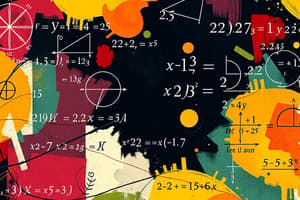Podcast
Questions and Answers
What is the purpose of isolating the resultant squared term in a quadratic equation?
What is the purpose of isolating the resultant squared term in a quadratic equation?
- To graphically analyze the intersection points with the x-axis
- To locate solutions by adding and subtracting appropriate quantities (correct)
- To simplify the equation by removing other terms
- To evaluate the discriminant for different solutions
Which method provides insights into the nature of a quadratic problem by plotting graphs?
Which method provides insights into the nature of a quadratic problem by plotting graphs?
- Graphical analysis (correct)
- Factoring
- Quadratic formula
- Completing the square
What does the quadratic formula yield for a quadratic equation?
What does the quadratic formula yield for a quadratic equation?
- Complex roots only
- All possible roots (correct)
- Only real roots
- One optimal root
In what scenario is graphical analysis less precise compared to other methods of solving quadratic equations?
In what scenario is graphical analysis less precise compared to other methods of solving quadratic equations?
What skill is emphasized as essential for success in mathematical pursuits when solving quadratic equations?
What skill is emphasized as essential for success in mathematical pursuits when solving quadratic equations?
How does knowledge of quadratic patterns extend beyond mathematics into other fields?
How does knowledge of quadratic patterns extend beyond mathematics into other fields?
What defines a quadratic expression?
What defines a quadratic expression?
Which method involves breaking down a quadratic expression into its factors?
Which method involves breaking down a quadratic expression into its factors?
What happens when a quadratic expression is equated to zero?
What happens when a quadratic expression is equated to zero?
In the quadratic expression $2x^2 + 5x - 3$, what are the coefficients of $x^2$ and $x$ respectively?
In the quadratic expression $2x^2 + 5x - 3$, what are the coefficients of $x^2$ and $x$ respectively?
What is the purpose of 'completing the square' in quadratic equations?
What is the purpose of 'completing the square' in quadratic equations?
Which type of roots can be easily found using the 'Factoring' method?
Which type of roots can be easily found using the 'Factoring' method?
Flashcards are hidden until you start studying
Study Notes
Algebra: Exploring Quadratic Equations
Quadratic equations have been captivating mathematicians since ancient times due to their intricate beauty and far-reaching applications. In this exploration of algebra, we'll delve into these jewel-like formulas that play such a significant role in our understanding of the world around us, starting with the fundamentals of quadratic expressions and moving towards solving various types of quadratics.
What is a Quadratic Expression?
A quadratic expression comprises terms raised to power two and lower powers. These can contain variables like (x), constants ((a, b, c...)), and addition, subtraction, multiplication, and division operations. For example, [ ax^2 + bx + c ] is a general representation of any quadratic expression. When we set up an equation by equating the quadratic expression to zero, it transforms into what's known as a quadratic equation.
Solving Quadratics
There are several methods at our disposal when tackling quadratic equations:
- Factoring: This method involves breaking down a quadratic expression into its factors after finding common binomial coefficients, resulting in two simpler linear equations. If successful, you may find real roots easily.
- Completing the Square: Although more conceptually complex, completing the square allows you to rewrite any quadratic expression inside an outer perfect square term ((ax^2+bx=a(x+\frac{b}{2a})^2-\frac{b^2}{4a})). Then, isolate the resultant squared term by adding and subtracting appropriate quantities, making the left side of your original equation equal to the right side.
- Graphical Analysis: By plotting graphs and looking at intersections with the x-axis, we can intuitively locate solutions of a given quadratic equation without explicitly calculating them. While less precise compared to other methods, graphical analysis offers insights into the problem's nature.
- Quadratic Formula: Regardless of whether the discriminant is positive, negative, or zero, the quadratic formula [ x = \frac{-b \pm \sqrt{b^2 - 4ac}}{2a} ] yields all possible roots of the quadratic equation[ ax^2 + bx + c = 0].
While there isn't necessarily one optimal approach to solve every quadratic equation, becoming proficient in multiple techniques will significantly increase your flexibility when navigating through problems—an essential skill necessary for success in mathematical pursuits.
Applications and Extensions
The study of quadratic relationships extends far beyond the realm of mathematics itself; they appear frequently across diverse fields such as physics, biology, economics, and architecture. From describing trajectories of projectiles and oscillatory motion to analyzing population dynamics and pricing structures, knowledge about quadratic patterns enables us better to understand the world around us. It also provides crucial stepping stones leading us towards higher levels of abstraction and sophistication in learning and applying advanced concepts, including polynomials, differential equations, and calculus, among others.
Studying That Suits You
Use AI to generate personalized quizzes and flashcards to suit your learning preferences.



